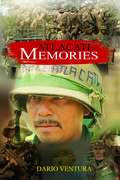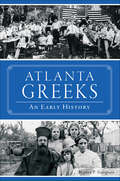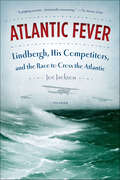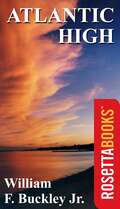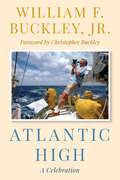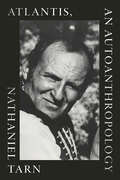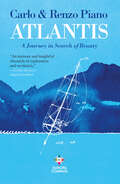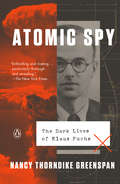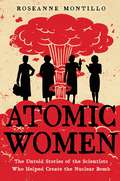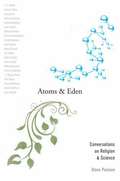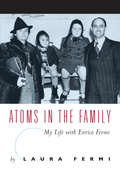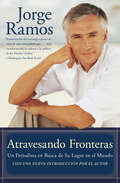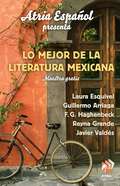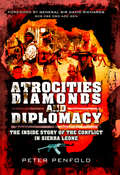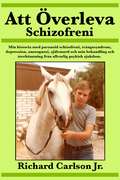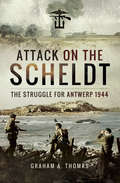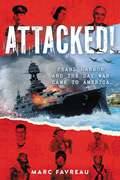- Table View
- List View
Atisa Dipamkara: Illuminator of the Awakened Mind (Lives of the Masters)
by James B. AppleThe first-ever biography with selected writings of one of the greatest Indian Buddhist masters in history.Few figures in the history of Buddhism in Tibet have had as far-reaching and profound an influence as the Indian scholar and adept Atiśa Dīpaṃkara (982–1054). Originally from Bengal, Atiśa was a tantric Buddhist master during Vajrayana Buddhism’s flowering in India and traveled extensively, eventually spending the remaining twelve years of his life revitalizing Buddhism in Tibet. Revered by all the schools of Tibetan Buddhism, Atiśa and his students founded what came to be known as the Kadam school, whose teachings have influenced countless Buddhist masters. These teachings, cherished by all major traditions, are preserved by the Geluk in particular, the school of the Dalai Lamas. Although Atiśa was an influential practitioner and scholar of Tantra, he is best known for introducing many of the core Mahayana teachings that are widely practiced throughout the Tibetan Buddhist world, including the Stages of the Path to Awakening and Mind Training (lojong), as well as having contributed to highly influential commentaries on Madhyamaka that synthesize various schools of thought. This succinct biography of Atiśa’s life, together with a collection of translations, represents for the first time the full range of Atiśa’s contribution to Buddhism. As the most comprehensive work available on this essential Buddhist figure, this book is an indispensable resource for scholars and Buddhist practitioners alike.
Atlacatl Memories: There is not anything to translate. (There is not anything to translate. #1)
by Jeffrey Stuart IsfeldMEMORIES FROM ATLACATL by Dario Ventura FROM WAR TO PEACE A story told by ex-Salvadoran military personnel of their life and experiences during the Salvadoran civil war Memories of Atlacatl Testimonial book on one of the battalions of the Salvadoran civil war: BIRl Atlacatl, testimonial narratives of its former members Today I got up with the invitation to continue as a mute observer of today's veterans of the civil war, in silence so as not to cloud The story that they are determined to tell without being observed, the change of opinion of the military has surprised me; After more than 30 years of the civil war, everyone has made a decision not to tell their stories, but in an act of no less heroism than during the war they have decided to expose part of their experiences during the war. I have put myself behind the monitor to watch and listen to the film of their own lives, the countless hours remembering what was never contacted before by their own authors, their memories, the memories of Atlacatl.
Atlanta Greeks: An Early History (American Heritage Ser.)
by Stephen P. GeorgesonBy 1890, the first Greek immigrants to Atlanta had settled into an area still widely populated by Confederate veterans. In a city without the large immigrant presence common in the nation's major urban areas, the Greeks were initially received as undesirable visitors by the state's and city's leaders. While the Greek Orthodox Church of Atlanta endured financial hardship, it continued to aid funerals, hospitals and orphanages. These Greeks moved from the city's streets as fruit vendors into more established businesses. Christ Gyfteas's fruit stand at the corner of Broad and Marietta became the California Fruit Company. By 1911, 40 percent of Greeks were proprietors or partners in a variety of businesses like cafés, restaurants, soda fountains and groceries. Author Stephen Georgeson explores the Greek immigrants' experiences in their first three decades in Atlanta.
Atlantic Fever: Lindbergh, His Competitors, and the Race to Cross the Atlantic
by Joe JacksonFor five weeks—from April 14 to May 21, 1927—the world held its breath while fourteen aviators took to the air to capture the $25,000 prize that Raymond Orteig offered to the first man to cross the Atlantic Ocean without stopping.Joe Jackson's Atlantic Fever is about this race, a milestone in American history whose story has never been fully told. Delving into the lives of the big-name competitors—the polar explorer Richard Byrd, the French war hero René Fonck, the millionaire Charles Levine, and the race's eventual winner, the enigmatic Charles Lindbergh—as well as those whose names have been forgotten by history (such as Bernt Balchen, Stanton Wooster, and Clarence Chamberlin), Jackson brings a completely fresh and original perspective to the race to conquer the Atlantic.Atlantic Fever opens for us one of those magical windows onto a moment when the nexus of technology, innovation, character, and spirit led so many contenders from different parts of the world to be on the cusp of the exact same achievement at the exact same time.
Atlantic Harvest: Memoirs of the Atlantic
by Ellery SedgwickEditor Ellery Sedgwick describes this collection as "stories, anecdotes, and opinions, controversial and otherwise; together with a variety of matter, relevant and irrelevant, accompanied by certain obdurate convictions." The book includes pieces published in the Atlantic Monthly between 1864 and 1946, by both long-forgotten writers and greats such as Mark Twain and Ernest Hemingway. It is a trove of treasures to be rediscovered.
Atlantic High
by William F. BuckleyAtlantic High is ostensibly the tale of Buckley's 1980 voyage across the Atlantic Ocean, a recond of Buckley's meditations on the pleasures of sailing and the importance of good company. Not surprisingly, as much thought seems to have gone into stocking the wine cellar as to charting the route across the high seas. This is an essay on appreciation, and a chance for Buckley to exercise his unique sense of humor and share his spirited point of view. After a leisurely aside-filled discussion of other trips, Buckley sets out with several close friends and a photographer to make his second trans-Atlantic crossing. The first crossing provided the basis for his popular book, Airborne. When asked by People magazine why he chose to make the crossing for a second time, Buckley replied with characteristic drollness, "the wedding night is never enough." It is a passion for sailing that motivates Buckley and enlivens these pages. The book ranges easily from observation to speculation, from humorous character sketch to wry editorial commentary. It is peppered with anecdotes, including one in which Buckley, armed with a hacksaw, breaks into a boatyard to steal his own boat back from an unscrupulous repairman. In another, President Reagan calls to discuss a conflict that is brewing in Africa, but all Buckley can think about is the weather ahead of him and his crew. From the Mujeres Islands to Fiji to Bermuda, to Sao Miguel and Gibraltar and beyond, the reader is treated to Buckley's observations of the places he visits and the people he encounters. A work as hard to categorize as Buckley himself, Atlantic High offers a real glimpse into Buckley's philosophical meanderings as well as the good life on the high seas.
Atlantic High: A Celebration
by William F. Buckley Jr.William F. Buckley Jr.'s account of his voyage across the Atlantic Ocean in the sailboat Sealestial, Atlantic High is a work that everywhere evidences Buckley's love for sailing and good companionship. Infused with his inimitable wit and supported by a rich fund of anecdotes and observations, Atlantic High is truly a one-of-a-kind work.
Atlantic High: A Celebration
by William F. Buckley Jr.In 1980, Buckley gathered together his friends and set out to sail across the Atlantic. This is what he correctly describes as a &“celebration&” of that thirty-day event. Here are the calms and the storms, the melodrama and the rumination, the wine and the song, the navigation and the introspection that in Buckley&’s distinctive blend capture the imagination of sailors and non-sailors, amuse the lighthearted and the dour, and engross the reader who wishes he were aboard, as also the reader who thanks heaven that he is not.
Atlantis, an Autoanthropology
by Nathaniel TarnOver the course of his long career, Nathaniel Tarn has been a poet, anthropologist, and book editor, while his travels have taken him into every continent. Born in France, raised in England, and earning a Ph.D. from the University of Chicago, he knew André Breton, Salvador Dalí, Marcel Duchamp, Margot Fonteyn, Charles Olson, Claude Lévi-Strauss, and many more of the twentieth century’s major artists and intellectuals. In Atlantis, an Autoanthropology he writes that he has "never (yet) been able to experience the sensation of being only one person.” Throughout this literary memoir and autoethnography, Tarn captures this multiplicity and reaches for the uncertainties of a life lived in a dizzying array of times, cultures, and environments. Drawing on his practice as an anthropologist, he takes himself as a subject of study, examining the shape of a life devoted to the study of the whole of human culture. Atlantis, an Autoanthropology prompts us to consider our own multiple selves and the mysteries contained within.
Atlantis: A Journey in Search of Beauty
by Carlo Piano Renzo PianoThe renowned architect and his son sail from Genoa in search of Atlantis in this “intimate and insightful chronicle of exploration and revelation” (Kirkus Reviews, starred review).Renowned architect Renzo Piano—whose credits include the New Whitney Museum, the Pompidou Center,the New York Times Building, and others—and his son Carlo, a well-regarded journalist, set sail from Genoa one late summer day. They went looking for the lost city of Atlantis, which, according to legend, was built to harbor a perfect society. They sails across the Pacific, along the banks of the Thames and the Seine, reaching as far as Athens, San Francisco’s Golden Gate Park, and Osaka Bay.Embarking not only on a life-changing journey but also on series of conversations that are humorous, irreverent, erudite, and always entertaining, Renzo and Carlo seek out the perfect city. Along the way, they reflect on their own relationship, on fathers and sons, on the idea of travel itself, and perhaps most notably on architecture, space, and the secret life of forms.
Atlas: From the Streets to the Ring: A Son's Struggle to Become a Man
by Peter Alson Teddy Atlas"Of all the people who have affected by my life and influence the choices I've made, none has been more important than my father."So begins the autobiography of legendary boxing trainer and commentator Teddy Atlas, who grew from the rebellious son of a doctor to a man who embraces, and lives by, his father's values and code.In this gritty, spellbinding tale, Atlas recounts his fascinating life -- as a juvenile delinquent on the streets of Staten Island; as a boxer and Golden Gloves champion under the tutelage of famed trainer Cus D'Amato; as a companion to the dangerous, unpredictable Sammy "the Bull" Gravano, up until the day Gravano turned rat and brought down crime boss John Gotti; and as a trainer of champions and contenders, among them fourteen-year-old Mike Tyson and heavyweight Michael Moorer, whom he led to the crown with a win over Evander Holyfield.Equally engrossing are Teddy Atlas's accounts of training dancer and choreographer Twyla Tharp for her successful comeback at age forty-two; his work with actor Willem Dafoe, preparing him for his role as a concentration camp boxer in the film Triumph of the Spirit; his journey to Poland to choreograph the film's boxing scenes; and his own performance in movies such as Play It to the Bone. In sharing his stories, Atlas reveals the philosophy by which he lives.Like Teddy Atlas -- inimitable, tough, honest, and wise -- this book inspires. It is about so much more than boxing. It is a story of overcoming hardships, of compassion for those in need, of tremendous personal integrity, and of personal and professional triumph.
Atmospheric Disturbances: Scenes from a Marriage
by Maggie May EthridgeTwo people deeply in love finally say their vows after ten years of friendship and uncertainty. But then the marriage takes a heartbreaking dive when one of them is diagnosed with bipolar disorder. The other struggles to stay afloat while raising their four children even as she confronts the uninvited guest of mental illness. Author Maggie May Ethridge asks: Am I welcome at the marriage table when my husband is lost to bipolar and my wedding band is being twisted in anxiety underneath the cloth? Less about the exact nature of bipolar disorder and more about the nature of love under fire, Atmospheric Disturbances brings us into the heart of a marriage.
Atomic Spy: The Dark Lives of Klaus Fuchs
by Nancy Thorndike Greenspan"Nancy Greenspan dives into the mysteries of the Klaus Fuchs espionage case and emerges with a classic Cold War biography of intrigue and torn loyalties. Atomic Spy is a mesmerizing morality tale, told with fresh sources and empathy." --Kai Bird, author of The Good Spy and coauthor of American Prometheus: The Triumph and Tragedy of J. Robert OppenheimerThe gripping biography of a notorious Cold War villain--the German-born British scientist who handed the Soviets top-secret American plans for the plutonium bomb--showing a man torn between conventional loyalties and a sense of obligation to a greater good.German by birth, British by naturalization, Communist by conviction, Klaus Fuchs was a fearless Nazi resister, a brilliant scientist, and an infamous spy. He was convicted of espionage by Britain in 1950 for handing over the designs of the plutonium bomb to the Russians, and has gone down in history as one of the most dangerous agents in American and British history. He put an end to America's nuclear hegemony and single-handedly heated up the Cold War. But, was Klaus Fuchs really evil?Using archives long hidden in Germany as well as intimate family correspondence, Nancy Thorndike Greenspan brings into sharp focus the moral and political ambiguity of the times in which Fuchs lived and the ideals with which he struggled. As a university student in Germany, he stood up to Nazi terror without flinching, and joined the Communists largely because they were the only ones resisting the Nazis. After escaping to Britain in 1933, he was arrested as a German émigré--an "enemy alien"--in 1940 and sent to an internment camp in Canada. His mentor at university, renowned physicist Max Born, worked to facilitate his release. After years of struggle and ideological conflict, when Fuchs joined the atomic bomb project, his loyalties were firmly split. He started handing over top secret research to the Soviets in 1941, and continued for years from deep within the Manhattan Project at Los Alamos. Greenspan's insights into his motivations make us realize how he was driven not just by his Communist convictions but seemingly by a dedication to peace, seeking to level the playing field of the world powers.With thrilling detail from never-before-seen sources, Atomic Spy travels across the Germany of an ascendant Nazi party; the British university classroom of Max Born; a British internment camp in Canada; the secret laboratories of Los Alamos; and Eastern Germany at the height of the Cold War. Atomic Spy shows the real Klaus Fuchs--who he was, what he did, why he did it, and how he was caught. His extraordinary life is a cautionary tale about the ambiguity of morality and loyalty, as pertinent today as in the 1940s.
Atomic Women: The Untold Stories of the Scientists Who Helped Create the Nuclear Bomb
by Roseanne MontilloBomb meets Code Girls in this nonfiction narrative about the little-known female scientists who were critical to the invention of the atomic bomb during World War II.They were leaning over the edge of the unknown and afraid of what they would discover there: Meet the World War II female scientists who worked in the secret sites of the Manhattan Project. Recruited not only from labs and universities from across the United States but also from countries abroad, these scientists helped in -- and often initiated -- the development of the atomic bomb, taking starring roles in the Manhattan Project. In fact, their involvement was critical to its success, though many of them were not fully aware of the consequences.The atomic women include:Lise Meitner and Irène Joliot-Curie (daughter of Marie Curie), who led the groundwork for the Manhattan Project from Europe;Elizabeth Rona, the foremost expert in plutonium, who gave rise to the "Fat Man" and "Little Boy," the bombs dropped over Japan;Leona Woods, Elizabeth Graves, and Joan Hinton, who were inspired by European scientific ideals but carved their own paths.This book explores not just the critical steps toward the creation of a successful nuclear bomb, but also the moral implications of such an invention. p.p1 {margin: 0.0px 0.0px 0.0px 0.0px; font: 13.0px Times}
Atoms and Eden: Conversations on Religion and Science
by Steve PaulsonHere is an unprecedented collection of twenty freewheeling and revealing interviews with major players in the ongoing--and increasingly heated--debate about the relationship between religion and science. These lively conversations cover the most important and interesting topics imaginable: the Big Bang, the origins of life, the nature of consciousness, the foundations of religion, the meaning of God, and much more. In Atoms and Eden, Peabody Award-winning journalist Steve Paulson explores these topics with some of the most prominent public intellectuals of our time, including Richard Dawkins, Karen Armstrong, E. O. Wilson, Sam Harris, Elaine Pagels, Francis Collins, Daniel Dennett, Jane Goodall, Paul Davies, and Steven Weinberg. The interviewees include Christians, Buddhists, Jews, and Muslims, as well as agnostics, atheists, and other scholars who hold perspectives that are hard to categorize. Paulson's interviews sweep across a broad range of scientific disciplines--evolutionary biology, quantum physics, cosmology, and neuroscience--and also explore key issues in theology, religious history, and what William James called ''the varieties of religious experience. '' Collectively, these engaging dialogues cover the major issues that have often pitted science against religion--from the origins of the universe to debates about God, Darwin, the nature of reality, and the limits of human reason. These are complex, intellectually rich discussions, presented in an accessible and engaging manner. Most of these interviews were originally published as individual cover stories for Salon. com, where they generated a huge reader response. Public Radio's "To the Best of Our Knowledge" will present a major companion series on related topics this fall. A feast of ideas and competing perspectives, this volume will appeal to scientists, spiritual seekers, and the intellectually curious.
Atoms in the Family: My Life with Enrico Fermi
by Laura FermiIn this absorbing account of life with the great atomic scientist Enrico Fermi, Laura Fermi tells the story of their emigration to the United States in the 1930s—part of the widespread movement of scientists from Europe to the New World that was so important to the development of the first atomic bomb. Combining intellectual biography and social history, Laura Fermi traces her husband's career from his childhood, when he taught himself physics, through his rise in the Italian university system concurrent with the rise of fascism, to his receipt of the Nobel Prize, which offered a perfect opportunity to flee the country without arousing official suspicion, and his odyssey to the United States.
Atoms in the Family: My Life with Enrico Fermi
by Laura FermiIn this absorbing account of life with the great atomic scientist Enrico Fermi, Laura Fermi tells the story of their emigration to the United States in the 1930s—part of the widespread movement of scientists from Europe to the New World that was so important to the development of the first atomic bomb. Combining intellectual biography and social history, Laura Fermi traces her husband's career from his childhood, when he taught himself physics, through his rise in the Italian university system concurrent with the rise of fascism, to his receipt of the Nobel Prize, which offered a perfect opportunity to flee the country without arousing official suspicion, and his odyssey to the United States.
Atrapado en una burbuja
by Ricardo Rábago Chávez Jack CollinsCon una perspicaz narrativa, el autor nos comparte la historia de un pre pubescente que sobrelleva la resiliencia sumido en un entorno disfuncional, con una madre amargada, controladora y egoísta; un padre castrante, en un ambiente escolar hostil e impersonal. Con mucha violencia sufrida en tan corta edad y una sexualidad atormentada, pero gracias a la gran sensibilidad y curiosidad intelectual, hacen que surja una persona valiosa, que muy a pesar de su larga depresión, trata de romper la burbuja en la que está atrapado, en la tenaz búsqueda para salvarse a sí mismo.
Atravesando Fronteras
by Jorge RamosRelato autobiográfico. Revela toda clase de detalles sobre la vida del famoso periodista Jorge Ramos. Por primera vez, este prestigiado presentador de noticias en Español comparte anécdotas conocidas y ocultas de su existencia con los lectores, televidentes y radioescuchas que han seguido atentos su despuntante carrera profesional. Descubrimos aquí al hombre cuya atracción por las emociones fuertes lo ha puesto reiteradamente en peligro, y cuyo sentido del humor lo ha salvado de las situaciones más incómodas. Padre, reportero, esposo e hijo; todas sus facetas se describen aquí, sin escatimar recursos. El sentido aventurero y práctico del protagonista nos brindará con la lectura, además, una excelente lección de vida. Los pasajes intensamente contados en el libro nos permitirán viajar de la mano de una persona que se confiesa itinerante; ofreciendo, por lo tanto, un amplio archivo emocional de vivencias recogidas de múltiples lugares y encuentros con los más variados y controversiales personajes del planeta.
Atria Español Presenta: Muestra gratis
by Laura Esquivel Reyna Grande Guillermo Arriaga F. G. HaghenbeckA Simon & Schuster eBook. Simon & Schuster has a great book for every reader.
Atrocities, Diamonds and Diplomacy: The Inside Story Of The Confict In Sierra Leone
by Peter PenfoldIn early 1997, Peter Penfold arrived in Sierra Leone as the British High Commissioner. This fascinating book describes not only his eventful three year tour but the background and subsequent events that placed this small country at the center of the world stage.During his tour, he found himself as right hand man to the countrys beleaguered President Kabbah. Due to rebel actions, including shocking atrocities, the author had to not only evacuate the international community (twice) but was forced out himself. At times he flew in daily from British warships as the situation was dangerously unstable.We learn how almost immediately after being praised by Prime Minister Tony Blair for his pivotal role in getting the once rich country back on its feet, he found himself under Customs and Excise investigation and Parliamentary Committee scrutiny for his supposed role in the Arms for Africa Enquiry. While reprimanded by the FCO, he was feted and made a Paramount Chief by the Sierra Leone people.He describes how, after his tour was cut short despite his and the host Governments appeals, the situation again deteriorated. He gives a highly informed account of the subsequent events including the SAS Operation BARRAS the rescue of the British military hostages. This is a very important account based on the most privileged knowledge.
Att Överleva Schizofreni
by Richard Carlson Jr. Berenice Arrieta CortésRichard Carlson Jr. diagnostiserades med paranoid schizofreni när han var tjugo år gammal. Hans sjukdom först manifesterade när han var en ung ungdom. Modern psykiatri misslyckades starkt Richard för över ett decennium. Därefter förstod han, efter en incident som involverade polisen, att hans diagnos var riktig och började äntligen den långa processen att återhämta sig. Över tio år senare förbättras hans liv väsentligt. Under sin behandling återhämtade sig också Richard från depression, tvångssyndrom och slöhet. Låt inte vad som hände med Richard hända dig, en nära anhörig, eller en patient som arbetar med allvarlig psykisk sjukdom. Alltid vara ärliga med varandra, och med din psykiater.
Attack on Everest
by Hugh RuttledgeIt was nine long years since the disappearance of Mallory and Irvine on the north face of Mount Everest. In the intervening years, the mountain had remained off limits. Suspicious of the foreign intrusions to Everest in 1921, 1922 and 1924, the Tibetan government had refused further expeditions permission to climb the mountain. Maybe the gods had not been happy, for already seven porters had perished on its mighty crags.Then in 1933 the Tibetan Government unexpectedly declared the mountain open again. The Mount Everest committee swung into action, and a new attempt was organised. The party set off from Darjeeling even earlier in the spring.All went well, with camps established above the East Rongbuk Glacier. The dangerous ice wall up to the North Col was breached. Camps were placed high on the northeast ridge. Of Mallory and Irvine there was no sign.But climbing Mount Everest is not just a struggle to conquer the ice walls and rocky precipices; it has as much to do with the fury of the gods, the wind, the monsoon clouds and the deathly intensity of the cold. In 1933 the gods were still angry, and the mountain remained aloof and daunting.In this volume some wonderful and now historic photographs beautifully illustrate the people, the countryside, the monasteries en route and the spectacular scenes from high on the mountain.So what was achieved by this fourth expedition to conquer Everest? Here is the fascinating story of that epic journey.
Attack on the Scheldt: The Struggle for Antwerp, 1944
by Graham A. ThomasDuring the Allied advance across northwest Europe in 1944, the opening up of the key port of Antwerp was a pivotal event, yet it has been neglected in histories of the conflict. The battles in Normandy and on the German frontier have been studied often and in detail, while the fight for the Scheldt estuary, Walcheren and Antwerp itself has been treated as a sideshow. Graham Thomass timely and graphic account underlines the importance of this aspect of the Allied campaign and offers a fascinating insight into a complex combined-arms operation late in the Second World War. Using operational reports and vivid first-hand eyewitness testimony, he takes the reader alongside 21 Army Group as it cleared the Channel ports of Calais, Boulogne and Dunkirk, then moved on to attack the Scheldt and the island stronghold of Walcheren. Overcoming entrenched German resistance there was essential to the whole operation, and it is the climax of his absorbing narrative.
Attacked!: Pearl Harbor and the Day War Came to America
by Marc FavreauThe true story of Pearl Harbor as you&’ve never read it before—action-packed, informative, and told through the eyes of a diverse group of people who experienced the terror of the unprecedented attack firsthand. A single day changed the course of history: December 7, 1941. Nobody in America knew Japan&’s attack on Pearl Harbor was coming. Nobody was prepared for the aftermath. It became a defining moment from which the country never truly recovered. Perfect for fans of Steve Sheinkin and Deborah Heiligman, this unflinching narrative puts readers on the ground in Pearl Harbor through the stories of real people who experienced the attack and its aftereffects. It alternates between the sweeping views and fateful decisions of leaders such as FDR and on-the-ground accounts from soldiers and sailors of all backgrounds as well as an array of other unique participants and observers. Attacked! sheds new, compelling light onto a history we think we know, what it means to be American, and the enduring lessons from an event we never saw coming.

